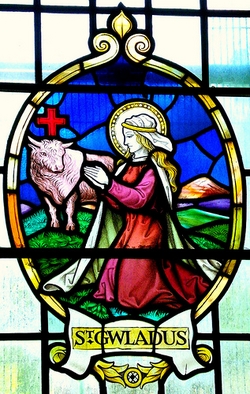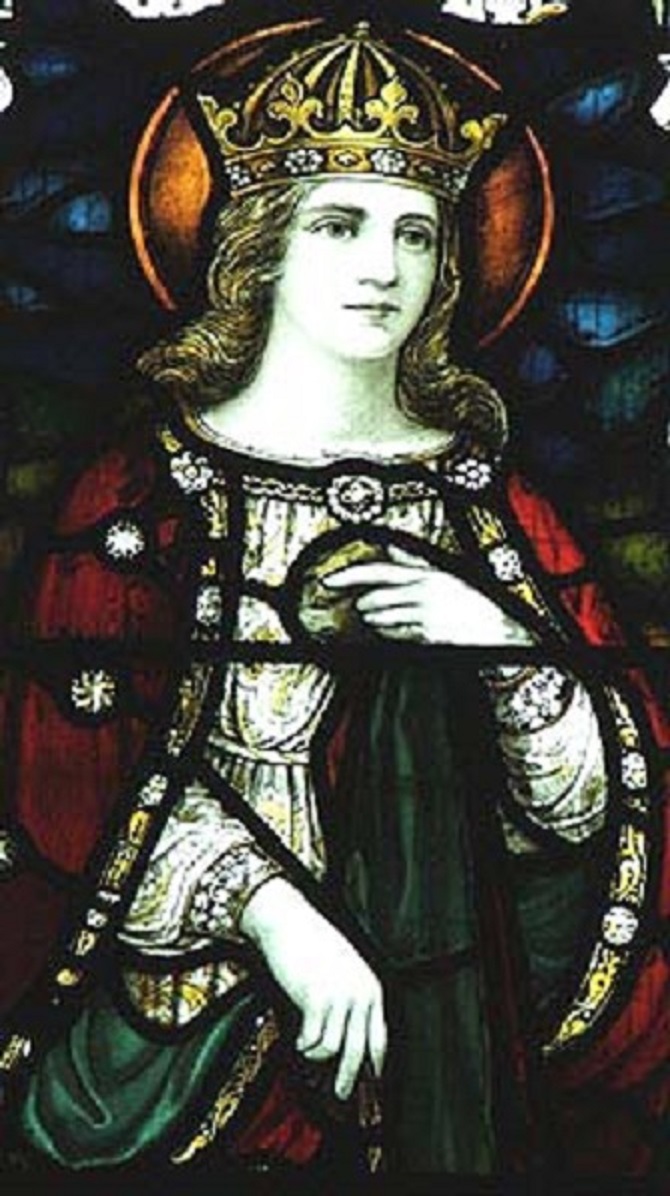Sainte Gladys
Reine, veuve et ermite (Ve siècle)
ou Gwladys.
Une des nombreuses reines des petits royaumes du pays de Galles. Sa fidélité conjugale laissa longtemps à désirer. Quand elle devint veuve, elle se fit ermite pour expier ses fautes et passa le reste de sa vie dans la solitude. Dieu pardonne, sainte Gladys en fit l'action de grâces par une vie toute donnée.
Selon la légende, elle aurait été enlevée par Gwynllyw, un roi voisin guerrier qu'elle aurait calmé... Ils seraient les parents de saint Cadoc et d'autres enfants saints aussi... Veuve, elle se retira dans un ermitage d'abord à Pencarnau puis à Gelligaer...
A lire aussi, sainte Gladys et saint Cadoc
SOURCE : https://nominis.cef.fr/contenus/saint/884/Sainte-Gladys.html
Gladys, prénom toujours apprécié dans le monde
anglo-saxon, était princesse du Pays de Galles.
Elle et son mari Gondlée étaient devenus des saints, non sans peine.
Gondlée, chef de clan, avait enlevé sa future épouse, dont la fidélité conjugale fut loin d'être exemplaire.
Or le fils de tels parents, Cadoc, se manifesta très vite, au contraire, comme un saint authentique.
Il eut assez d'influence pour amener ses parents à quitter leur existence brutale.
Devenue veuve, Gladys se convertit et se fit ermite, vivant dans la prière et la pénitence au bord de la rivière Ebbwé, dans l'Ouest de l'Angleterre.
Elle termina sa vie dans la paix de la conversion du cœur.
Quant à son fils, devenu Moine, il fonda un Monastère dans la région de Cardiff, puis se réfugia avec ses Moines en Armorique, notre Bretagne, lors de l'invasion des tribus saxonnes.
Ayant rencontré Saint Gildas, le Moine Cadoc portera l'Évangile dans la région de Vannes en Morbihan.
Ainsi, le fils et la mère se sont retrouvés par la Miséricorde du Seigneur qui « écrit droit avec les lignes courbes de nos vies ».
De retour en Angleterre, Cadoc prend soin de ses compatriotes, les Celtes des comtés orientaux combattant les conquérants saxons, qui le livrent au martyre à Weedon.
Il avait mené jusqu'au bout le beau combat de la Foi.
Le prénom Cadoc, ou encore Kadeg, a d'ailleurs le sens, en celtique, de "combattant valeureux".
Cette notice fait référence au dictionnaire
hagiographique intitulé Dix mille saints et rédigé par les Bénédictins de
Ramsgate en Angleterre (Éditions Brépols).
Un saint, une vie
Sainte Gladys, pécheresse galloise
LECOEUR Xavier,
le 23/03/2013 à 00:00
Il arrive qu'un enfant soit l'instrument inattendu,
l'aiguillon providentiel, de la conversion de ses parents. On peut le constater
de nos jours lorsqu'un adolescent demande lui-même le baptême, entraînant
parfois dans son sillage lumineux son père et sa mère étonnés, intrigués,
troublés.
L'histoire de la sainteté nous en donne également des
illustrations, notamment avec sainte Gladys (ou Gwladys) qui vécut au Ve
siècle. Fille aînée du roi gallois chrétien Brychan, elle était d'une grande
beauté et avait séduit un petit seigneur local nommé Woolos (on le connaît
aussi sous les noms de Gwynllyw ou de Gondlée). Woolos demanda Gladys en
mariage, mais se heurta au refus net et catégorique de Brychan qui ne voulait
pas donner sa fille à un homme réputé pour sa brutalité et son impiété.
Woolos, qui était très amoureux et n'avait pas
l'habitude qu'on lui résiste, ne s'en laissa pas conter. À la tête d'une petite
armée de trois cents hommes, nous dit la légende, il se serait alors rendu au
château de Talgarth, où vivait Gladys, et l'aurait enlevée pour en faire sa
femme.
Pendant plusieurs années, les deux époux menèrent une
existence mouvementée, faite de violences, de rapines et de brigandages. Leur
vie conjugale était également très agitée, Gladys n'étant pas la moins infidèle
des deux.
Mais le Seigneur avait fait à ce couple peu vertueux
un cadeau de choix, en la personne de leur premier fils: Cadoc. Sous
l'influence bénéfique de ce moine et futur saint, Gladys et son mari prirent
peu à peu conscience de leur impiété et de l'impasse où les menait leur
inconduite. Ils décidèrent alors d'entamer, d'abord ensemble, puis séparément,
un chemin de pénitence. Woolos renonça à son pouvoir et se retira dans une
petite cabane, située sur une colline près de la ville actuelle de Newport.
Quant à Gladys, elle quitta également le monde et se fit ermite, au bord d'une
rivière voisine. Jusqu'à sa mort, l'ancienne épouse impie et volage vécut dans
la prière et dans l'austérité, afin d'expier ses fautes et d'obtenir le pardon
de Dieu.
Sa trajectoire est particulièrement parlante en ce
temps de Carême, où chacun est invité, quelle que soit l'étendue de ses fautes,
à « se convertir », à « croire à l'Évangile » et à écouter
le Christ lui redire comme à la pécheresse: « Je ne te condamne pas. Va,
et désormais ne pèche plus » (Jn 8, 11).
Aller à sa rencontre
Un livre: The Lives of the British Saints (« Les Vies
des saints britanniques »), par Sabine Baring-Gould et John Fisher (Londres,
1911).
Saint Gladys
Outlaw who became a saint
Wife, Mother, and Hermit (d. ca 500)
Her life
The life of Saint Gladys (or Gwladys)—who is said to have been born in Wales and was the daughter of Brychan of Brecknock—is shrouded in legend and mystery.
When the chieftan Gwynllyw (who was later honored as a saint) asked for her hand in marriage, Gladys’ father refused and Gwynllyw and Gladys ran away together and lived as bandits.
Later, at Glady’s urgings, Gwynllyw chose to stop running and to embrace the Christian Faith. The couple later had a child, who has come to be honored as Saint Cadoc of Llancarfan.
Gladys later became a hermit in rural Wales and became the object of great devotion after her death sometime after the year 500.
Spiritual bonus
Saint Gwynllyw is also honored on this day and, so tradition tells us, he later became a monk at Newport, Wales, and, later, a hermit. An Anglican cathedral in Newport, Wales, is dedicated to his memory.
For reflection
“May all your works thank you, O Lord, and all your Holy ones bless you. They shall speak of the glory of your reign, and declare your mighty deeds.”—Entrance Antiphon for Mass of the Common of Holy Men and Women, For Several Saints
Prayer
May the prayer and integrity of the Saints, O Lord, we
pray, obtain help for your faithful, that they may gain a share in the eternal
inheritance of those whom they celebrate with devotion. Through our Lord Jesus
Christ, your Son, who lives and reigns with you in the unity of the Holy
Spirit, one God, for ever and ever. Amen.
(from The Roman Missal: Common of Holy Men and
Women—For Several Saints)
Saint profiles prepared by Brother Silas Henderson,
S.D.S.
SOURCE : https://aleteia.org/daily-prayer/friday-march-29/
Also known as
Gwladys
Gwaladys
Gladusa
Gwladus
Claudia
Profile
Daughter of Saint Brychan
of Brecknock. When Saint Gwynllyw asked
for her hand in marriage, Brychan
refused. Gwynllyw kidnapped the girl, and
the two started a violent life on the run. Mother of Saint Cadoc
of Llancarvan who eventually convinced Gwynllyw and
Gladys to give up their violent ways, and follow a religious calling. Nun at
Newport, Monmouthshire, Wales.
Late in life she became a hermitess in
rural Wales.
Born
Additional
Information
Book of
Saints, by the Monks of
Ramsgate
Book of
Saints, by the Monks of
Ramsgate
books
Our Sunday Visitor’s Encyclopedia of Saints
other
sites in english
images
video
sites
en français
fonti
in italiano
MLA
Citation
“Saint Gladys“. CatholicSaints.Info.
29 September 2022. Web. 24 March 2023.
<https://catholicsaints.info/saint-gladys/>
Born in Wales in the 5th century. One of the 24 children of Brychan of Brecknock, wife of Saint Gundleus (f.d. today), and mother of Saint Cadoc (f.d. September 25) and, possibly, Keyna (f.d. October 8), Saint Gladys led a very interesting life. It is said that after their conversion by the example and exhortation of their son, she and Gundleus lived an austere life. It included the rather interesting practice throughout the year of taking a nightly baths in the Usk, followed by a mile-long walk unclothed. Her son finally convinced them to end the practice and to separate. Gladys moved to Pencanau in Bassaleg. The details of her story come from a 12th-century "vita," which includes miracles that took place in the time of Saint Edward the Confessor (f.d. October 13) and William I (Attwater2, Benedictines, Delaney, Farmer, Husenbeth).
SOURCE : http://celticsaints.org/2014/0329b.html
Santa Gladys (Gwladys) Regina
La vita di questa regina
gallese degli inizi del VI sec., ci è nota attraverso quella di suo marito, s.
Gwynllyw scritta ca. nel 1130 e una Vita dell'XI ic. del suo grande figlio s.
Cadoc.
Gwlady era la maggiore
delle ventiquattro figlie di s. Brychan di Brecknock e fu data in sposa
(secondo la Vita Gunlei) al regulus del Galles sud-orientale di nome Gwynllyw:
secondo la Vita Cadoci ella fu rapita da questi, aiutato nell'impresa da re
Arthur.
Sempre la Vita Cadoci, in
contrasto con la Vita Gunlei, descrive i primi anni del matrimonio di Gwlady
come ben lungi dall'essere esemplari; tuttavia sembra che il figlio Cadoc li
persuadesse ad emendarsi. Gwynllyw si ritirò nel luogo che si chiama oggi Stow
Hill (Newport) dove esiste un'antica chiesa dedicata a s. Wooloo, mentre Gwlady
scelse un luogo non molto lontano sulle sponde del fiume Ebbw.
Sebbene entrambi
conducessero vita di penitenza, Cadoc li costrinse a separarsi piú
completamente, cosí Gwlady si diresse verso una "solitudine montana"
a Pencarnau nel Bassaleg dove costruì una chiesa in onore della Vergine.
La festa di Gwlady e di
suo marito è fissata al 29 marzo ed i loro nomi sono ricordati in varie chiese
e pozzi nel Galles meridionale; in particolare quello di Gwlady in un pozzo a
Tredegar Park e in una chiesa nella diocesi di Llandaff (prima del 1146).
Autore: Leonard
Boyle
SOURCE : http://www.santiebeati.it/dettaglio/47625
Voir aussi : https://catholicsaintsguy.wordpress.com/2016/03/29/the-memorial-of-two-merry-marrieds/

